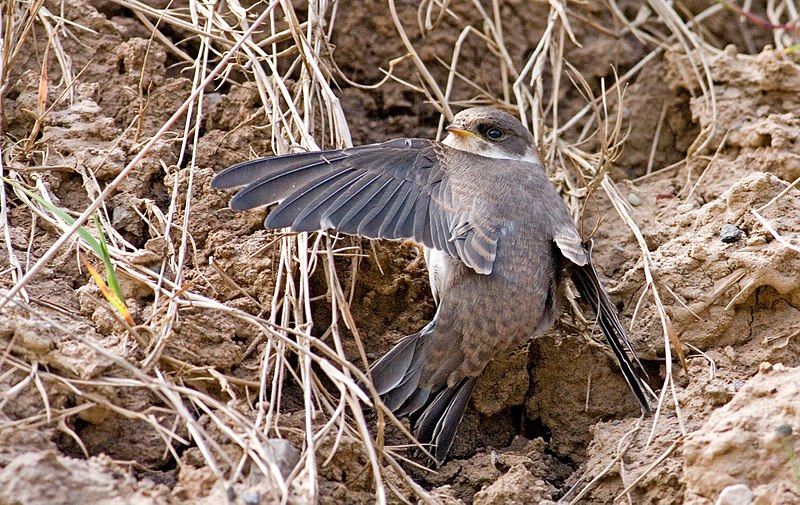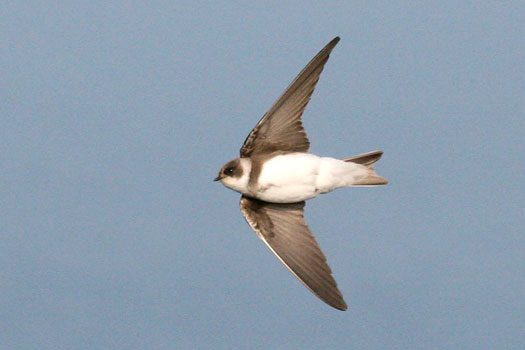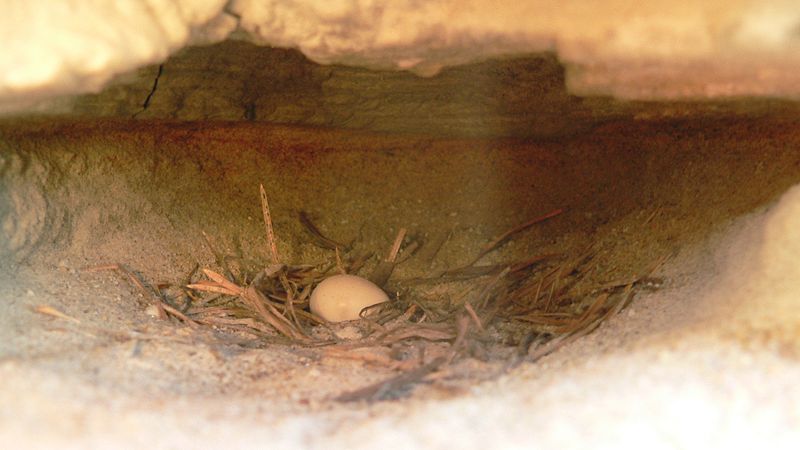.

Sand Martin (Riparia riparia), Seaham, County Durham, England: photo by Myosotis Scorpiodes, 9 January 2009
Thou hermit haunter of the lonely glen
And common wild and heath -- the desolate face
Of rude waste landscapes far away from men
Where frequent quarrys give thee dwelling place
With strangest taste and labour undeterred
Drilling small holes along the quarrys side
More like the haunts of vermin than a bird
And seldom by the nesting boy descried
Ive seen thee far away from all thy tribe
Flirting about the unfrequented sky
And felt a feeling that I cant describe
Of lone seclusion and a hermit joy
To see thee circle round nor go beyond
That lone heath and its melancholly pond
And common wild and heath -- the desolate face
Of rude waste landscapes far away from men
Where frequent quarrys give thee dwelling place
With strangest taste and labour undeterred
Drilling small holes along the quarrys side
More like the haunts of vermin than a bird
And seldom by the nesting boy descried
Ive seen thee far away from all thy tribe
Flirting about the unfrequented sky
And felt a feeling that I cant describe
Of lone seclusion and a hermit joy
To see thee circle round nor go beyond
That lone heath and its melancholly pond
John Clare: Sand Martin, written between 1824 and 1832, first published 1935
Adult Sand Martin (Riparia riparia) at nest site on Baltic Sea cliff in Dziówek, Poland. The two burrow entrances open into a nest cavity built at the end of a tunnel about 60 cm deep: photo by Eidzej, 11 July 2006

Sand Martins (Riparia riparia), at cliffside nest site, Psel River, Poltava Oblast, Ukraine: photo by Vitaliy Khustochka, 17 July 2012
Sand Martin (Riparia riparia) at its cliffside nest in Heiligenhafen: photo by Aiwok, 22 May 2010
Sand Martin (Riparia riparia) at its nest. The colony is located on the steep cliffs of Fyns Hoved, Funen, Denmark: photo by Malene Thyssen, 18 July 2004
Active breeding colony of Sand Martins (Riparia riparia): photo by Andreas Trepte, 4 May 2008

Colony of Sand Martins (Riparia riparia) nesting on the side of a cliff, Turkish Kurdistan: photo by Dûrzan Cîrano, 5 June 2010
Nest of Sand Martin (Riparia riparia), with egg. The nest is built in a burrow dug into the sand, which the male or female access through a corridor extended to about 50-60 cm depth (when the sand layer is deep enough): photo by Axel Strauss, 6 July 2006

Sand Martin (Riparia riparia) in flight: photo by Richard Wesley, 27 February 2011
Young Sand Martin (Riparia riparia) in flight, Markinch, Fife, Scotland: photo by Nigel Wedge, 16 September 2011
Sand Martins (Riparia riparia) resting on power transmission line, Pleshkani, Cherkasy Region, Ukraine: photo by Шатилло, 27 July 2010










17 comments:
nice images...love the gestures and postures of the birds...:)
Many thanks, Sandra.
Clare, who looked so closely at everything in the landscape about him, didn't need a birder's guidebook to get at the essence of the curiosity of the particular behavioural habits of these wonderful little birds.
Where frequent quarrys give thee dwelling place
With strangest taste and labour undeterred
Drilling small holes along the quarrys side
More like the haunts of vermin than a bird
It is a pleasure to see them gathered in their colonial "hauntings":
A busy Sand Martin hotel on a sand bank of the River Ayre, West Yorkshire
Sociable Sand Martins at St. Ives bay, Cornwall
(Their ability to make happy use of power transmission lines, as seen in the bottom photo here from the Ukraine, and in the video from St. Ives, suggests that perhaps there is a purpose to be found by some living being for everything manufactured by Industrious Man -- though of course IM had no such purpose in mind.)
lovely...:)
Yes, beautiful. I love looking at birds. They do decide where to live and that's it--like in our gutters and one year, right over our mailbox. No matter how many times you try to convince them to try another spot . . .
I can't get enough of watching these little guys. Here's a colony of Swedish Sand Martins popping in and out of their holes (do they really know whose is whose?), working on burrowing, scrabbling about and generally making it seem that being a Sand Martin would be a wonderful thing:
Sand Martins being Sand Martins
(I understand that the nest burrows contain only a single egg apiece, and are abandoned after hatching, due to the incursions of vermin -- making Clare's observation about the "haunts" perhaps more accurate than he might have known.)
Nin, many thanks, missed that until just now.
The beautiful thing about creatures other than humans is that one can never convince them of anything.
(Just think of all those centuries of important advice they've missed out on.)
(Oh, and my bad for mispelling the name of that Yorkshire stream. It's the River Aire -- presided over in the greater scheme of things by, of course, the interdependent Natural Departments of Air and Water.)
Fragile monastic apartments
cleaned out
dynamic feathers
need scrubby sand
left the bugs
of the "melancholly pond"
behind.
Your cousins--
velvet.
You, mealy-colored
slipping
sky
glazy eyes
back from the library.
"Thou hermit haunter of the lonely glen"
Thou bandaged passenger of my remembering brain,
Thou pacer of Poetry Magazine
ponderer of shortness,
Thou carrier of an unsheathed, bejeweled dagger ready to unleash...
Thou mumbling and preserved under the sand, casting spells left and right,
Thou obscure ghost just a little too real, milky, gauzy quartzy electricity,
Thou dictator of measured passion, as in step-by-step,
Thou sandy mirror in the shallow river.
Tiny hawk
your egg
inside the cool
royal chamber
is where I want to live
after travels
inside
air with no edge.
"With strangest taste and labour undeterred"
Lots to think about here.
To see thee circle round nor go beyond
That lone heath and its melancholly pond
Poverty of place, true localities; these limits bring to mind the last stretches of common land, to learn to live with the propriety of others' fences as best you can.
Only Clare could use the word vermin and give it a life beyond the general and required disgust.
I love all swifts and martins. The pictures and the films fill up my heart.
These fly boys and girls are called "stone swallows" in Hellas--what a flight for sore eyes every Spring!
Stone swallows: I like that very much.
Thanks to the observer of things wild and common Clare and to the wonderful Riparia riparia then, full hearts all round.
One can hardly imagine that the beauty of these photographs could be equaled by the mere words of a single man but here we have it - the opposite is true - the photographs, gorgeous as they are, struggle to match this amazing man, John Clare, whose immediate intuitive feeling for these little beings makes one feel that he, too, is something of the flitting martin, "in lone seclusion and a hermit joy ..." Beautiful, Tom.
Don,
Thanks for the alert reading, sensitive and as always going straight to the heart of the matter.
I think that sense of identification of the observing poet (is he "the nesting boy" I wonder?) with the bird here is real and palpable. He is so accustomed to feeling singular and alone, it seems he transfers -- in fact for a moment almost imposes -- that lonesome singularity "Of lone seclusion and a hermit joy" upon the Sand Martin (though as he can't have helped but notice, these are the most sociable of birds, happy in their busy colonies).
I don't think it's the dread "pathetic fallacy" at work, so much as a kind of purposive empathy (as you suggest), an in-feeling ("immediate intuitive feeling," as you so nicely put it) that he finds indescribable because it is beyond description. And too he appears to have seen some member(s) of the colony split off from the group, and climb up into "the unfrequented sky" -- free as a bird, like they say.
Post a Comment